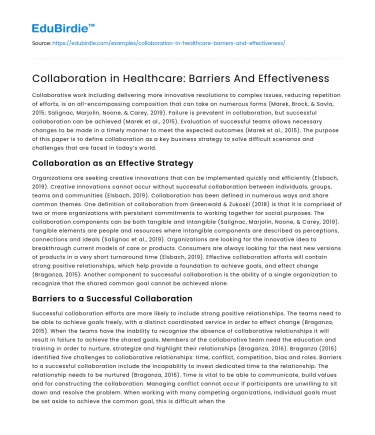Collaborative work including delivering more innovative resolutions to complex issues, reducing repetition of efforts, is an all-encompassing composition that can take on numerous forms (Marek, Brock, & Savla, 2015; Salignac, Marjolin, Noone, & Carey, 2019). Failure is prevalent in collaboration, but successful collaboration can be achieved (Marek et al., 2015). Evaluation of successful teams allows necessary changes to be made in a timely manner to meet the expected outcomes (Marek et al., 2015). The purpose of this paper is to define collaboration as a key business strategy to solve difficult scenarios and challenges that are faced in today’s world.
Collaboration as an Effective Strategy
Organizations are seeking creative innovations that can be implemented quickly and efficiently (Elsbach, 2019). Creative innovations cannot occur without successful collaboration between individuals, groups, teams and communities (Elsbach, 2019). Collaboration has been defined in numerous ways and share common themes. One definition of collaboration from Greenwald & Zukoski (2018) is that it is comprised of two or more organizations with persistent commitments to working together for social purposes. The collaboration components can be both tangible and intangible (Salignac, Marjolin, Noone, & Carey, 2019). Tangible elements are people and resources where intangible components are described as perceptions, connections and ideals (Salignac et al., 2019). Organizations are looking for the innovative idea to breakthrough current models of care or products. Consumers are always looking for the next new versions of products in a very short turnaround time (Elsbach, 2019). Effective collaboration efforts will contain strong positive relationships, which help provide a foundation to achieve goals, and effect change (Braganza, 2015). Another component to successful collaboration is the ability of a single organization to recognize that the shared common goal cannot be achieved alone.
Save your time!
We can take care of your essay
- Proper editing and formatting
- Free revision, title page, and bibliography
- Flexible prices and money-back guarantee
Barriers to a Successful Collaboration
Successful collaboration efforts are more likely to include strong positive relationships. The teams need to be able to achieve goals freely, with a distinct coordinated service in order to effect change (Braganza, 2015). When the teams have the inability to recognize the absence of collaborative relationships it will result in failure to achieve the shared goals. Members of the collaborative team need the education and training in order to nurture, strategize and highlight their relationships (Braganza, 2016). Braganza (2016) identified five challenges to collaborative relationships: time, conflict, competition, bias and roles. Barriers to a successful collaboration include the incapability to invest dedicated time to the relationship. The relationship needs to be nurtured (Braganza, 2016). Time is vital to be able to communicate, build values and for constructing the collaboration. Managing conflict cannot occur if participants are unwilling to sit down and resolve the problem. When working with many competing organizations, individual goals must be set aside to achieve the common goal, this is difficult when there are scarce resources to go around and the organizations are contending for them. This can hamper sincere and candid communication and eventually damage relationships (Braganza, 2016). Previous negative connotations need to be set aside in order to overcome bias. Finally, there needs to be clear definition of roles, responsibilities and goals. It needs to be clear what organization is responsible for contributions, time and resources or the collaboration is at risk for failure (Braganza, 2016).
Recognizing and Evaluating Effective Collaboration
Although the believed advantages of collaboration may be agreed upon, successful collaboration is challenging to achieve and failure is predominant (Marek, Brock, & Savla, 2015). Greenwald and Zukoski’s (2018), essay address the challenges that are faced to properly measure successful collaboration. They attest that instruments being used focus more on an individual assessment of satisfaction, the community and efficacy of leadership. The usual evaluation tool is about relationships, climate and expectations (RCE). Greenwald and Zukoski (2018) offer an alternative with the approach of extent of collaboration (EC) as an evaluation tool. The extent of collaborative action asks members which services they provided freely as opposed to the partnership with the other organizations (Greenwald & Zukoski, 2018). The authors suggest that evaluators assess collaboration primarily through perceptions among individual participants regarding satisfaction with their partnerships, belief in their leadership and positivity regarding success. The EC gives more concrete information to measure collaboration than REC to determine if the organizations is achieving their goals (Greenwald & Zukoski, 2018).
Collaboration in Healthcare
The dynamic nature of healthcare organizations means that collaboration has come to be crucial for many (Salignac et al., 2019). Collaborations among researchers and across disciplines, administrative and cultural limitations are essential to address progressively more complex challenges and prospects in science and society (Hall et al., 2018). Salignac et al. (2019) aim of their paper was to test the effectiveness of their Collaboration Health Assessment Tool (CHAT) and the validity of the associated measures. They looked at three components to analyze the validity of the tool. First, they classified active characteristics of collaboration to provide a strong basis for developing measures of success to systematically investigate collaboration health (Salignac et al., 2019). Secondly, they proposed an enhanced measure of collaboration that utilizes a systems methodology.






 Stuck on your essay?
Stuck on your essay?

